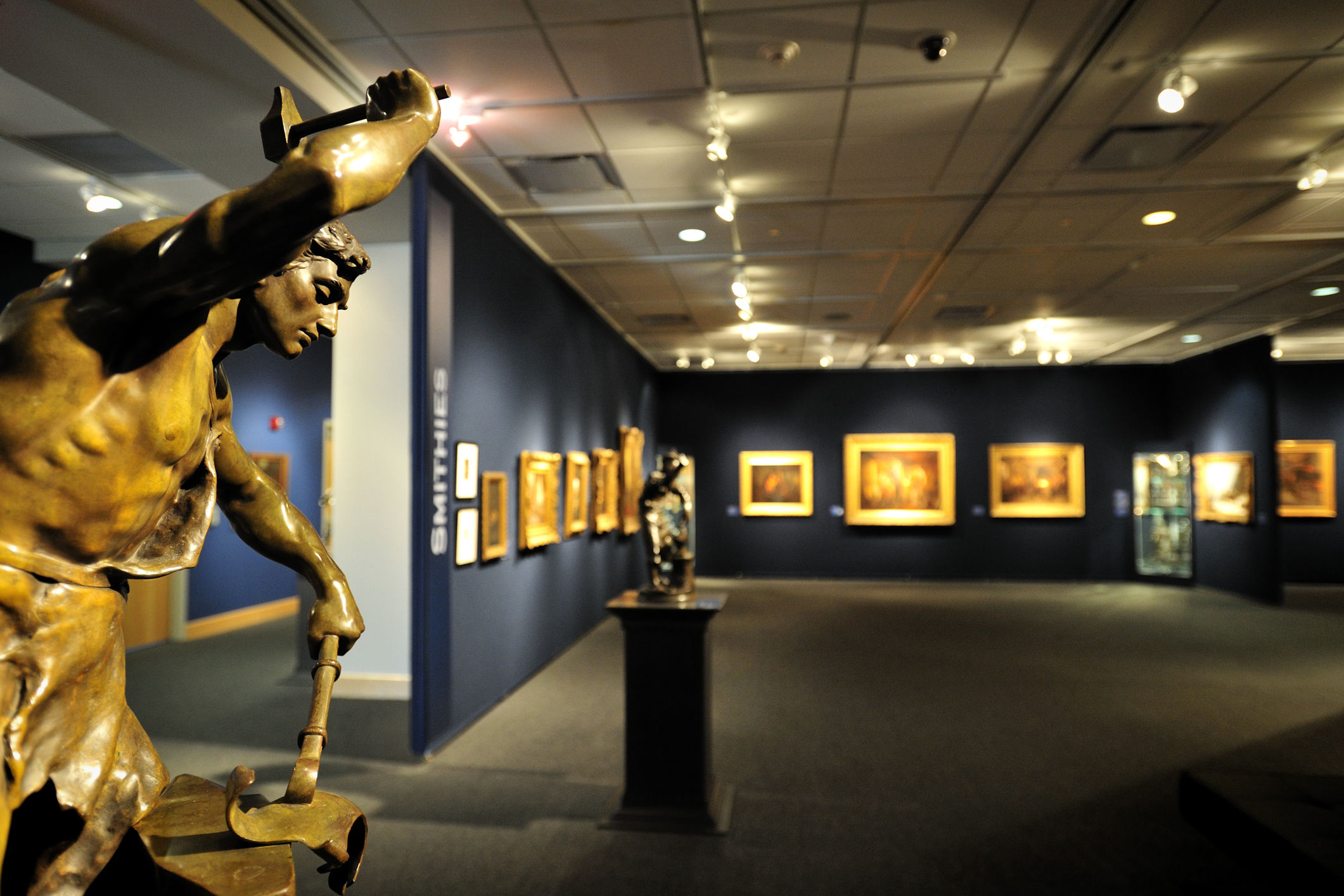How an Academic Uncovered One of the Biggest Museum Heists of All Time
When a Danish dealer named Ittai Gradel blew the whistle on stolen British Museum antiquities showing up online, it was the culmination of a year-long antiques who dunit
ITTAI GRADEL, an academic–turned–gem dealer in Denmark, was trawling eBay a decade ago when he thought he had stumbled across a gold mine.
On his screen, Gradel saw a seller called Sultan1966 advertising a glass gem from the 19th century. Gradel immediately recognized it as something much more valuable: an agate Roman Medusa cameo from the second century, featuring the mythical Gorgon with snakes as hair. He snapped it up for £15 plus postage, then turned around and sold it to a collector for a couple of thousand pounds.
In the following years, Sultan1966 kept unearthing incredible finds at rock-bottom prices. Gradel bought a ring for £150, which he assumed was a copy of one from the Ptolemaic kingdom, an ancient Greco-Egyptian empire. But when he received the item and verified it was an original from over 2,000 years ago, Gradel told Sultan1966 he had mispriced his ring and sent him an extra £500. “It was ridiculous,” he remembers thinking.
Gradel inquired as to how the seller, an Englishman whose name was listed as Paul Higgins, had come across these items. Sultan1966 said he had acquired them from his grandfather, who owned a junk shop in York, in northern England, and died in 1953. Gradel checked the death records and found that such a man with the matching name did indeed die, but in 1952. The ludicrously low prices and oddly credible backstory left Gradel comfortable that he had encountered every dealer’s dream seller. “He was clueless,” recalls Gradel.
Then, in 2016, Sultan1966 posted a piece on eBay by mistake. It showed a fragment of a sardonyx cameo dating from Roman times engraved with the head and shoulder of a girl stooping to her right. Intrigued, Gradel screenshotted the item. Sultan1966 quickly removed it from the website and said that it actually belonged to his sister, who didn’t want to sell it.
Gradel thought not much more about it. But in 2020, he came across an image on the British Museum’s website that showed the exact same item in its collection. Furthermore, the color photograph was recent. It suddenly dawned on Gradel: There was a thief in the British Museum. “And he was likely still within the walls,” he says.
So began an antiques whodunit—whose cast of characters include an Oxford-based priest-cum-archaeologist, a handful of rare-gem dealers and some of the British Museum’s most august researchers—that has shaken the premise behind the museum’s most important reason for existing: that it is the best place to safely house some of the world’s greatest treasures.
This summer the British Museum said that around 2,000 items had gone missing from its collection. The museum’s director resigned. The police are on the case. So far, no one has been charged with a crime. But nations from Nigeria to China have used the scandal to further long-running requests to have items stored in the museum returned. The damage to the museum’s reputation is potentially incalculable, and many of the allegedly stolen items may never be found.
The art world is full of tales of audacious heists involving high-profile pieces, from the former Louvre worker in 1911 who simply snatched the Mona Lisa on his way home to the two men who swiped Edvard Munch’s The Scream from an Oslo museum in 1994, leaving behind a note to its directors thanking them for the poor security.
In this case, Gradel suspects, what happened was far more humdrum—and, therefore, more disturbing. The British Museum had failed to properly catalog thousands of its pieces. Meanwhile its curators had free rein over one of the biggest treasure troves in the world. And one had possibly gone rogue.
The 58-year-old Gradel makes for an unlikely Hercule Poirot. Sipping a tomato juice in a central London bar on a September afternoon, the academic rattles through the precise details of his interactions with the museum and gives an impassioned description of the engraved stones he has seen and collected over the years.
As a young man, the Israeli-born Gradel worked as a railwayman on the London Underground to pay for his studies. After studying archaeology, and a stint in British academia, which he greatly disliked, he decided in 2008 to trade antiques.
He started with books but discovered that it was already a widely mined market. He switched to a more niche specialty: gems from the Greco-Roman period. Only a handful of experts possess enough knowledge to sort ancient glass or semiprecious engraved stone gems from latter-day copies. Gradel, who has no office and works from a modest house on an island in Denmark, spends his days scouring the wares of auctions and dealers, trying to find mispriced cameos and intaglios that he can buy and sell at a profit.
Gradel has one major advantage over fellow dealers: a photographic memory. Peter Szuhay, a London-based dealer who has known Gradel for over a decade, says Gradel has memorized which hairstyles ancient Romans wore in different years, a skill that helps him to accurately date portraits carved into gems. “No other dealer would have caught the thief,” Szuhay says.
Around the time that Gradel saw the sardonyx piece in 2020, which he suspected came from the British Museum, he made another worrying discovery. Back in 2015, Sultan1966 had put up for sale a fragment of a green stone showing the profile of a Roman man with a likeness to Emperor Augustus. The profile on the stone had a distinct lock of hair sticking out of the front, a feature Gradel noted was unusual for Roman coiffure at the time. Gradel lost the bid to a fellow dealer, who bought it for £69.
A few years later, another dealer, Malcolm Hay, who now owned the piece, tried to sell it. An intermediary sent it to Gradel to see if he was interested in the fragment, which measures roughly the width of a finger.
A while after, Gradel read a book by a Polish gem specialist that featured an image of a stone from a 1926 British Museum catalog blown up on a large scale. “I thought that looked familiar,” he recalled thinking. There, in the book, was the gem with the same Roman profile and the same distinctive hairstyle. That, along with a couple of tiny scratches on the man’s nasal ridge, matched exactly the piece Gradel received a year earlier. Clearly, Gradel concluded, they were the same piece.
Sitting in his study in Denmark, he then went through his payments to Sultan1966, or Paul Higgins, checking out his PayPal account. Though the seller listed his name as Paul Higgins on eBay, he had a different name on his PayPal account: Peter Higgs. At first Gradel didn’t think much of this—he hadn’t heard of anyone of that name. Then he called a dealer friend of his, Rolf von Kiaer, who had also bought items from Sultan1966, to explain the weird situation. “Ittai,” a shocked Kiaer told him. “You do realize this is the name of a curator in the British Museum, don’t you?”
Gradel felt the hairs on his neck begin to stand up. But the evidence accumulated. Paul Higgins’s email was Bodrum1966@gmail.com, an oblique reference to an ancient Greek city in Turkey. Higgs, a curator in the museum’s department of Greece and Rome, had once published a book called After the Mausoleum: Hellenistic Sculptures From Bodrum in the British Museum. Higgs’s Twitter handle was @sultan1966.
Gradel was floored. Still, he had to be sure that the pieces he had seen on eBay were indeed from the British Museum’s collection and weren’t just replicas knocking around the antiques market. It would be no small feat: Only around 4.5 million of the 8 million estimated pieces in the British Museum have been cataloged online.
Gradel emailed Martin Henig, an 81-year-old archaeologist and priest who is one of the world’s foremost gem experts at Oxford University. Henig quickly dusted off the 1926 Catalogue of the Engraved Gems and Cameos, Greek, Etruscan and Romanin the British Museum, which he happened to have in his home library. Grainy images indicated the pieces Gradel had flagged were indeed original and had resided in the museum.
Gradel also raised the alarm with Hay. In 2020 Hay, a wiry Englishman from west London, went to the museum, which was half empty because of the pandemic, to meet with its deputy director, Jonathan Williams, and another curator from the gem collection. The meeting was slightly surreal, Hay says. The British Museum officials talked vaguely about how the museum had been bombed during World War II, which disturbed some of the collections, Hay recalls. After being thanked, he asked if he could see some more gems, but was instead bustled away and told they were all in boxes. Hay gave them the stone but left bemused. “At no point during the meeting did they say, ‘This is our gem,’ ” he said.
Then—nothing happened. Gradel became obsessed with the idea that he had inadvertently traded stolen goods. “If I had given up on this, then I would have become complicit,” he says. He flitted between despair at the prospect of the British Museum being dragged through the mud and feeling like a coward for not immediately naming the suspected thief outright. Higgs meanwhile was promoted to acting keeper of Greek collections.
In early 2021, Gradel decided to email Williams, laying out, in a somewhat manic way, his conclusions. “I write to you because of a disturbing discovery I have made, involving theft from the British Museum, apparently by one of your curators,” he wrote. For months, he received no reply. Then Williams emailed back to inform him that his fears were misplaced, an investigation had concluded and that the gems he had inquired about were still in the collection.
Gradel then made a mistake. He shared his finding with Dorothy Lobel King, an archaeologist-turned-author, as he weighed the idea of leaking the news via social media. It later transpired that King went straight to Higgs to ask him about the allegation. King declined to comment.
Suspicious that a cover-up was underway, Gradel asked his dealer friend who had initially bought the green Augustus gem from Sultan1966 whether the British Museum had bothered to ask him about his purchase. It hadn’t. Clearly the internal probe was a joke, he concluded.
In October 2022, Gradel got the contact details of a trustee of the British Museum and emailed him to warn him a thief was on the loose and the museum management wasn’t doing anything about it. The trustee forwarded the email to the chair of the British Museum, George Osborne, who ordered a fresh probe. This summer the British Museum announced it had fired a member of its staff after items from its collection had vanished, including some dating back to the 15th century B.C. It said it would launch an independent inquiry into security and kick-start a program to recover the lost items. Days later, it emerged that the staff member fired was not a janitor or clerk, but Higgs. Williams also stepped back from day-to-day duties.
Higgs’s son told the U.K. media he believes his father is innocent. Efforts to contact Higgs were unsuccessful.
The curator was a stalwart of the British Museum, where he worked for the past three decades. Higgs briefly gained notoriety as one of the museum’s “Monuments Men” who helped identify looted pieces. In interviews at the time, he spoke passionately about his field and how he fell in love with ancient artifacts as a young boy. The 56-year-old did not appear to be living in great luxury. He was recently photographed outside his terraced house in Hastings, where he drives a Nissan Micra. Top-level keepers at the British Museum typically earn around £65,000 a year, according to recent job postings; middle-ranking curators make less.
In the aftermath, Gradel has been in contact with police and the museum’s independent investigation. He says that upon opening a drawer, the British Museum staff found almost an entire collection of 935 individually uncataloged gems missing. Perhaps another 150 pieces with gold fixtures or mountings may have been melted down and sold off.
The British Museum declined to comment on the ongoing probe, or on Higgs’s alleged involvement, but said it was accelerating the cataloging process under new management. The museum says the vast majority of the missing items are from the department of Greece and Rome. It added they mainly consist of gems and gold jewelry. “We were the victims of an inside job by someone who, we believe, over a long period of time was stealing from the museum, and the museum had put trust in,” Osborne, the British Museum’s chair, recently told a British parliamentary committee. He added the thefts may have gone on for up to 25 years and the alleged culprit altered computer records to hide his thefts. The museum has so far recovered 350 items.
A representative for London’s Metropolitan Police Service declined to comment on the specifics of the case but said the police force had interviewed a man in August.
Gradel, Henig and others involved still can’t understand why anyone would take the risk to sell valuable items at such a discount, let alone a curator who had devoted his life to protecting and understanding these ancient artifacts. They speculate that it must be a volume play that went on for years in hopes that a drip-drip of small underpriced items wouldn’t attract attention. “It only made sense if only the tiniest tip of a much larger iceberg,” Gradel says.
Particularly shocking was the idea that some of these ancient gold pieces may have been melted down. The Roman cameo owned by Hay was chipped, indicating it may have cracked while being prized out of a ring mount. The 2,000-year-old ring Gradel had bought from Sultan1966 had nicks around the edge, which he suspects were caused by pliers to test whether it was made from gold (it wasn’t). Melting down antique jewelry reduces its value, but once sold or made into new jewelry, it becomes untraceable.
Recently Gradel went back through his other purchases—in particular a cluster of several hundred gems he bought for £20,000 between 2010 and 2013. The seller, says Gradel, claimed in an email to be an elderly English gentleman who said they were heirlooms from an estate sale in northern England. Gradel recalls how, in 2011, a fellow dealer offered to meet the vendor on Gradel’s behalf. But shortly before they were due to meet, the vendor’s purported son emailed to say that the elderly man had passed away. The old fellow was called Paul Higgins.
Gradel says he is preparing to hand that collection of around 290 gems back to the British Museum, as he assumes they were pilfered. After that he won’t devote time to hunting down the remaining gems on the open market. “My work,” he says, “is done.”
 Copyright 2020, Dow Jones & Company, Inc. All Rights Reserved Worldwide. LEARN MORE
Copyright 2020, Dow Jones & Company, Inc. All Rights Reserved Worldwide. LEARN MORE
This stylish family home combines a classic palette and finishes with a flexible floorplan
Just 55 minutes from Sydney, make this your creative getaway located in the majestic Hawkesbury region.
There are Corvette fans for whom the base US$68,300 car is plenty powerful enough. After all, it produces 495 horsepower and can reach 60 miles per hour in 2.9 seconds. But hold on, there’s also the approximately US$115,000 Z06—with 670 horsepower and able to reach 60 in 2.6 seconds. These split seconds are important for busy people—and for marketing claims. And if that’s not enough go power, there’s the even more formidable 900-horsepower ZR1 version of the Corvette, starting around US$150,000. The hybrid E-Ray, at US$104,900, is pretty potent, too.
But if they’re still too slow, fans of American-engineered muscle can consider the exclusive Texas-built Hennessey Venom F5, a limited-edition carbon-fibre hypercar. Ten years ago, the Hennessey became the world’s fastest production car, defeating the Bugatti Veyron Super Sport, with a top speed of 270.49 miles per hour.
That world title is much sought after, and is currently held by the Sweden-built 1,600-horsepower Koenigsegg Jesko Absolut, with a two-way average top speed of 277.8 mph. But Hennessey is still very much a contender. The company is hoping the 1,817-horsepower F5 (with 1,192 pound-feet of torque) can exceed 300 mph on the track this year.

Hennessey photo
Hennessey’s previous Venom GT model (introduced in 2010) was based on the Lotus Exige, with a GM LS-based engine, and was built by partner Delta Motorsport. Spokesman Jon Visscher tells Penta , “The new Venom F5, revealed in 2020, is a 100%bespoke creation—unique to Hennessey and featuring a Hennessey-designed 6.6-litre twin-turbo V8 engine boasting 1,817 horsepower, making it the world’s most powerful combustion-engine production car.” Leaps in performance like this tend to be pricey.
This is a very exclusive automobile, priced around US$2.5 million for the coupe, and US$3 million for the F5 Roadster announced in 2023. Only 30 Roadsters will be built, with a removable carbon-fiber roof. The 24 F5 coupes were spoken for in 2021, but if you really want one you could find a used example—or go topless. In a statement to Penta , company founder and CEO John Hennessey said that while the coupe “is now sold out, a handful of build slots remain for our Roadster and [track-focused] Revolution models.”
Only 24 Revolutions will be built in coupe form, priced at US$2.7 million. There’s also a rarefied roadster version of the Revolution, with just 12 to be built.

Hennessey photo
The Venom F5 coupe weighs only 3,000 pounds, and it’s not surprising that insane speeds are possible when combined with a hand-built motor (nicknamed “Fury”) created with power uppermost. The V8 in the F5, installed in a rear mid-engine configuration, has a custom engine block and lightweight forged aluminium pistons, billet-steel crankshaft, and forged-steel connecting rods. Twin turbochargers are featured. The F5 can reach 62 mph in less than three seconds, but top speed seems to be its claim to fame.
The driver shifts the rear-wheel-drive car via a seven-speed, single-clutch transmission with paddle shifters. The interior is not as spartan or as tight as in many other supercars, and is able to handle very tall people. The butterfly doors lift up for access.
“With 22 customer Venom F5 hypercars already delivered to customers around the world, and a newly expanded engineering team, we’re focusing the Venom F5 on delivering on its potential,” Hennessey says. “Breaking 300 mph in two directions is the goal we aim to achieve toward the end of this year to claim the ‘world’s fastest production car’ title.”
Hennessey says the car and team are ready. “Now the search is on for a runway or public road with a sufficiently long straight to allow our 1,817-horsepower, twin-turbo V8 monster to accelerate beyond 300 mph and return to zero safely.” The very competitive Hennessey said the track-focused Revolution version of the F5 set a fastest production car lap around Texas’ 3.41-mile Circuit of the Americas track in March, going almost seven seconds faster than a McLaren P1.
The Revolution features a roof-mounted central air scoop (to deliver cool air to the engine bay), a full-width rear carbon wing, larger front splitter and rear diffuser, tweaked suspension, and engine cooling. It’s got the same powertrain as the standard cars, but is enhanced to stay planted at otherworldly speeds.
This stylish family home combines a classic palette and finishes with a flexible floorplan
Just 55 minutes from Sydney, make this your creative getaway located in the majestic Hawkesbury region.






















